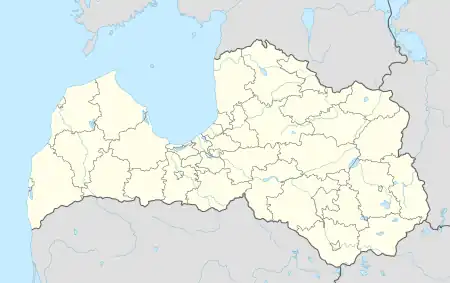Auce | |
|---|---|
Town | |
.jpg.webp) Auce | |
 Coat of arms | |
 Auce Location in Latvia | |
| Coordinates: 56°27′N 22°53′E / 56.450°N 22.883°E | |
| Country | |
| District | Dobele Municipality |
| Town rights | 1924 |
| Government | |
| • Mayor | Vija Keršus |
| Area | |
| • Total | 3.67 km2 (1.42 sq mi) |
| • Land | 3.61 km2 (1.39 sq mi) |
| • Water | 0.06 km2 (0.02 sq mi) |
| Population (2023)[2] | |
| • Total | 2,173 |
| • Density | 590/km2 (1,500/sq mi) |
| Time zone | UTC+2 (EET) |
| • Summer (DST) | UTC+3 (EEST) |
| Postal code | LV-3708 |
| Calling code | +371 637 |
| Number of city council members | 8 |
| Website | www |
Auce (ⓘ; Lithuanian: Aukė; German: Alt-Autz) is a town in southern Latvia, Dobele Municipality near the Lithuanian border.
History
Before 13th century the territory of Auce was a part of a Semigallian Spārnene county. After the partition of Semigallia in 1254 territory was granted to the Archbishopric of Riga. Auce is first mentioned in written sources in 1426 as Owcze. In 1616 Old Auce (German: Alt-Autz) manor is mentioned for the first time when there was held regional assembly (landtag) of the Duchy of Courland. In 1667 the first Lutheran church was erected in Auce. From 1768 until the Latvian agrarian reforms in the 1920s, Old Auce manor was property of the Baltic German von Medem family.
Auce village started rapid development after the construction of the Jelgava-Mažeikiai railway in 1889. During the World War I Auce was occupied by the Imperial German army. The Germans established an aviation school and airfield (Artillerie-Fliegerschule Ost I) nearby.
After the Latvian War of Independence Auce became part of the Republic of Latvia. In 1920 Old Auce manor was nationalised and it became the property of the University of Latvia, to be used as a teaching farm for students of agriculture. In 1924 Auce received town rights. Was Auce has been the centre of the Auce municipality. But in 2021 Auce Municipality was merged with the Dobele Municipality.
 Cemetery of German soldiers killed during World War II in Auce.
Cemetery of German soldiers killed during World War II in Auce.
See also
References
- ↑ "Reģionu, novadu, pilsētu un pagastu kopējā un sauszemes platība gada sākumā". Central Statistical Bureau of Latvia. Retrieved 18 January 2023.
- ↑ "Iedzīvotāju skaits pēc tautības reģionos, pilsētās, novados, pagastos, apkaimēs un blīvi apdzīvotās teritorijās gada sākumā (pēc administratīvi teritoriālās reformas 2021. gadā) 2021 - 2022". Central Statistical Bureau of Latvia. Retrieved 2 October 2023.
External links